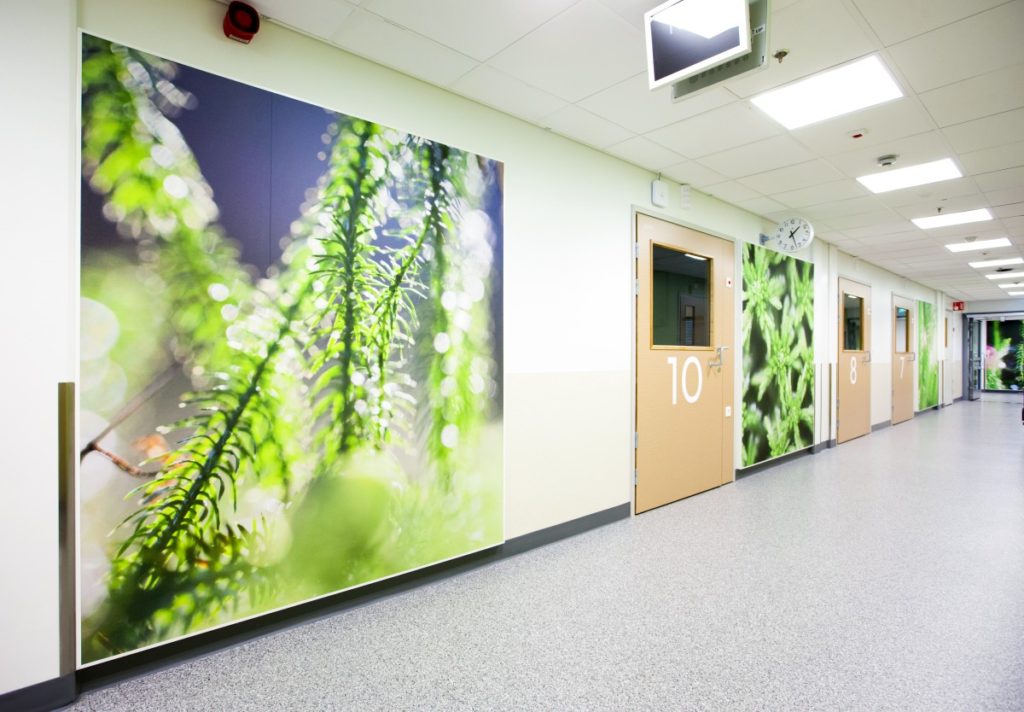For more than decade, ‘Evidence Based Design’ (EBD) has been part of our DNA in regards to building healthcare facilities. When it comes to indoor climate we know that lighting, air quality and acoustics are crucial parameters in healing architecture together with biophilic designs for the eye, the ear and the mind.
Furthermore, we need to consider how our buildings can be more sustainable – the building material we use need to have as little impact on the planet as possible, we need to secure profit – and last but not least, we need to build a sustainable and efficient environment for PEOPLE no matter where they are:
Office workers in a building with low emitting products and good air quality scored 61% higher in cognitive function test.[2]
Also in the education sector we see the same trend and when it comes to acoustics we know that it affects teaching and learning massively and research also concludes that good acoustics lower heartrates[3].
Patient issues
Let us look at the efficiency in the healthcare sector – what issues are we actually dealing with and what could the solutions be
Patients first.

In Denmark it is estimated that 10% of all patients get a bloodstream infection during a hospital stay – and there is a risk of 20% of dying because of that infection.[4] This is surely connected to a higher cost since the patient will have to stay longer in the hospital, getting more medicine, cure and care. In Denmark it is tax-payers’ money – in other countries it can be insurance money.
Infections and length of stay
Alone in American hospitals, the Centers for Disease Control (CDC) estimates that these healthcare-acquired infections (HCAI), also known as nosocomial infections, account for an estimated 1.7 million infections and 99,000 associated deaths each year and the annual economic impact was approximately US$ 6.5 billion.
According to the WHO, HCAIs cause 16 million extra days of hospital stay in Europe and 37,000 attributable deaths, and contribute to an additional 110,000, every year.[6] In a world where the risk of ‘super bugs’ is increasing there is therefore a constant focus on overuse of antibiotics and on hygiene demands. Overuse of antibiotics is a topic on itself and can lead to great healthcare crisis in general.
Indoor climate contributions
It is undoubtful that the indoor climate contributes either negatively or positively to these issues and it is undoubtful that the cost of EBD-hospitals where room acoustics are prioritized is lower in the long run.
In a business case by Sadler et al.[7] less noise was considered to contribute to less adverse drug effects and reduced nursing turnover at the same time as noise reduction by installing acoustic ceilings and wall panels contributed to less sleep deprivation, quicker recovery and decreased stress (high-performance acoustic ceilings were used in all patient care areas). Finally, in this case the premium for EBD was estimated at 7.2% of total building cost AND the payback time for EBD at this hospital was estimated at only 3 years!

Room acoustics are crucial
When it comes to sound and acoustics we know that patients, no matter if they have just gone through a serious heart surgery or suffering from a pneumonia need to recover quickly to avoid infections – and a successful recovery is based on sleep. Sleep, unfortunately, is a luxury in healthcare facilities of today that have become small cities who work around the clock. It is estimated that the average restorative period for a patient in the ICU is as short as 6.2 minutes![8]
Sound levels
Since the 60ies, actual sound pressure levels have increased in level – both during daytime and nighttime – and it is not unusual to have sound pressure levels sufficiently high to interfere with sleep, affect speech intelligibility and create a level of background noise that will annoy and affect most people.[9]
A noisy healthcare facility where the room acoustics don’t support the activities will never be efficient – and the result will be more patient infections[10], more medication[11] and a healthcare staff that cannot perform. Let us look at how the staff is affected by sound and acoustics.
Staff issues
.jpg)
…sometimes I’m not sure if they don’t hear what I’m saying or if they don’t understand what I’m saying![12]
Neurologist in Denmark working with people with dementia.
Noise levels can make it impossible for staff members to diagnose correctly at the same time as the patients don’t always hear what the care giver said. Because of demographic changes we see older and older people in our healthcare facilities and because of age-related hearing loss and sometimes cognitive deficits it is harder for the staff members to receive the correct information from the patient. This can lead to mistakes and the patient cannot always hear because of poor acoustics and the answers will not be fulfilling.
Mistakes increase with bad acoustics
In general, our bodies and brains have developed for the outdoors. If we compare the time we have lived outdoors as cave men to the time we have been living inside – we see a huge difference in time. Our hearing has not changed since we lived outside, and in this environment we needed our hearing to survive – if we didn’t react we would die. We needed both to react to the information in the sound (was it an animal or just the wind?) as well as the loudness to know whether to react, fight, flight or flee.
Healthcare staff are often working in conditions where fast decisions and precision work are key factors to an efficient treatment. Unfortunately, the sound environment can play a negative role if the acoustics are not supporting the activities and the ‘cave man’ of the care giver will be challenged.
Mistakes in the operation room
In a hospital in Denmark, staff members working in three similar (m2, geometry, equipment etc.) operation rooms stated that the room acoustic treatment of the facilities affected them[13]. The three rooms were designed with different acoustic treatment – going from minimum treatment (acoustic ceiling – absorption class C) to medium treatment (acoustic ceiling – absorption class A) to maximum treatment (acoustic ceiling and wall panels – absorption class A).
Results from a questionnaire revealed that the staff members were more likely to make mistakes in the operation room with less acoustic treatment and the communication events in the same room were also troublesome:
I don’t know where the sound is coming from – I cannot orient.[14]
Operation Nurse about the less treated room.
Mistake leads to respiratory arrest
In an advisory report based on healthcare staff reporting to the PAPSRS (Pennsylvania Patient Safety Reporting System (USA)) many examples of real-life medical errors due to mishearing were found[15].
Knowing that the only real record of a verbal order is in the memories of those involved it was not surprising to find that background noise and interruptions because of sound peaks could lead to mistakes. Some of the reported mistakes were as follows:
+ An emergency room physician verbally ordered ‘morphine 2 mg IV’ but the nurse heard ‘morphine 10 mg IV’. The patient received a 10 mg injection and developed respiratory arrest.
+ A physician called in an order for ‘15 mg’ of hydralazine to be given IV every 2 hours. The nurse, thinking that he had said ‘50 mg’ administered an overdose to the patient who developed tachycardia and had a significant drop in blood pressure.
+ A phone order mistaken for Toradol 50 mg was administered prior to the pharmacy review, when the intended dose was 15 mg.
Healthcare efficiency, sound and acoustics
The healthcare sector is complex no matter where you go, we will see more and more people in the facilities and more and more tasks to solve, and room acoustics play just one part in the big play. However, the investment in room acoustics seem to make sense. If you compare the money you spend on this with the benefits you gain, it is a sustainable investment in efficiency – even without data and research saying that you the payback time is only 3 years![16]
Patients sleep better, heal better, get less infections and get well faster if they are in calm sound environments and staff perform better with less mistakes in working environments where the communication is clear and the background noise is low.
(Cre_ acousticbulletin.com)
Xem định vị:
- Tổng công ty: Cụm Công Nghiệp Lại Yên, Xã Sơn Đồng, TP. Hà Nội.
- Kho Mỹ Đình: Đối diện 304 đường K2, Cầu Diễn, Nam Từ Liêm, Hà Nội.
- VP Trường Chinh: Số 36, ngõ 120 đường Trường Chinh, phường Kim Liên, TP. Hà Nội.
- Nhà máy: KCN Bình Phú, Phường Kỳ Sơn, Tỉnh Phú Thọ.
- Chi nhánh Đà Nẵng: Số 575, Đường Lê Văn Hiển, Hòa Hải, Ngũ Hành Sơn, Đà Nẵng.
- Chi nhánh Sài Gòn: Số 181/7 Dương công khi, Ấp 9, xã Hóc Môn, TP. Hồ Chí Minh.
* Để rõ đường đi và thuận lợi cho đôi bên Quý khách vui lòng Click vào đây để xem chi tiết.